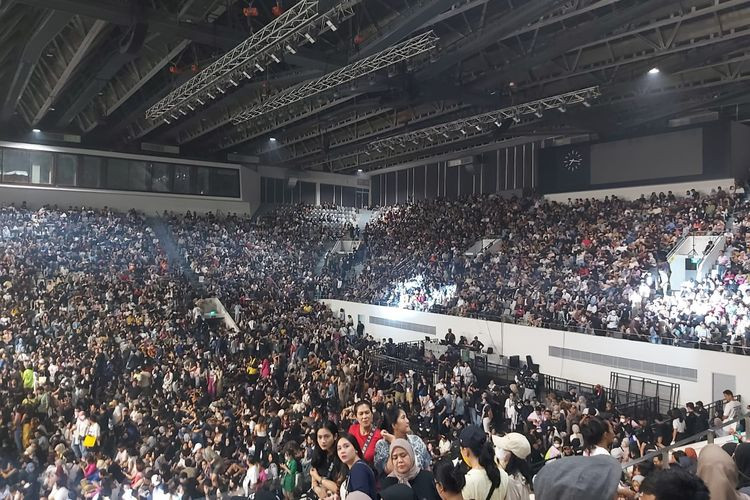Keeping big events safe from stampedes
Change Size

V
em>Veteran event organizers, crowd experts and concertgoers discuss ways to prevent overcrowding tragedies from happening at large-scale events.
On Oct. 29, South Korea saw at least 156 mostly young people killed in a crush at Seoul’s first post-pandemic Halloween party. Meanwhile, the Democratic Republic of the Congo saw a stampede that killed nine spectators and two police officers during a packed concert by local singer Fally Ipupa at the country’s biggest stadium in the capital city of Kinshasa.
Last Saturday night, the Berdendang Bergoyang music festival venue also saw crowds beyond its capacity, leading to at least 27 people being hospitalized. According to a report on Kompas.com, the festival had over 21,000 people at Istora Senayan, Central Jakarta, when the event’s permit was for only 3,000 spectators.
The chaos forced the Central Jakarta Police to cut the festival short and cancel Sunday, the last day.
Better safe than sorry
“There are three main things event organizers should be transparent about with the police. The first one is the venue’s capacity,” Harry “Koko” Santoso, CEO of concert organizer Deteksi Production, told The Jakarta Post on Wednesday.
Police also need to know how many tickets will be sold and who will perform at the show, he continued.
Having organized big festivals like Soundrenaline and concerts for popular bands since 1997, Koko stressed the need for organizers to count the number of people that can fit in a venue to prevent overcrowding.
“It’s safe to say that 1 square meter can fit two or three people,” Koko said, explaining the general rule used by event organizers worldwide.
Other organizers expect fewer people, like the local music festival Joyland, which has a more laid-back atmosphere.
“Our formula for Joyland is one person for 1 square meter of space since [our audience] like to sit around on the grass,” Joyland’s program director Ferry Dermawan shared with the Post through a call on Thursday.
Gita Suhardi, whose crowd control and event staffing agency GSH PRO has managed international concerts from Katy Perry to Blackpink, said it was essential to communicate clearly with the organizers, stakeholders and the ticketing team.
“I must know exactly how many thousands of people will be in the venue,” she said to the Post on Wednesday.
With more than a decade of experience, Gita shared that every promoter and event organizer she has worked with always leaves 20 percent available space among the crowd.
“There should never be 100 percent capacity in an event,” Gita opined. She explained that filling a venue to the brim on paper will lead to more people in the field since there are always extra tickets for media or invited guests.
The ticketing team also plays a pivotal part in manually checking the tickets that have been scanned or counted so that they “know if there are already 8,000 people inside the venue at 6 p.m. when the maximum capacity is 10,000 people,” she said. At that point, it is wise for the promoter to close the doors, even for those with tickets.
Crowds can also be put in order as they go into the venue using queuing numbers.
“From what I experienced at the [K-pop group] NCT concert in Singapore, queuing numbers are very important and doable as it minimizes disturbances among the fans,” 23-year-old Atika Khairana Pradistia told the Post on Thursday.
Race organizer and founder of Pandara Sports, Andreas Kansil, who specializes in mass participation sports, also weighed in on how overcrowding can be avoided in an open street and moving crowds, which was the case in South Korea’s tragedy.
“For a running event that hosts 5,000 people, we have to consider how wide the road is, how elevated it will be, and potential bottleneck spots since all of those things affect the participants’ speed and [safety],” Andreas said to the Post on Wednesday. “Sometimes, we also have to anticipate the participants’ numbers by creating additional access for space [on the road].”
Unwritten rules
There have yet to be written rules for event organizers nationwide to follow. The Indonesian Music Promoters Association (APMI) thus plans to devise a manual on attaining security permits and other standard operational procedures for all promoters and event organizers.
“There are a lot of event organizers that don’t realize that [acquiring a permits and ensuring event safety] is a long process,” APMI head of program Dewi Gontha said during a press conference at M Bloc Space in South Jakarta on Thursday.
“We as promoters never work on our own. We invite other parties to help [with crowd control],” Dewi said, referring to Gita’s GSH PRO. “Never assume that you, as an organizer, can control a crowd by yourself.”
Due to the overcrowding incidents, several concerts slated for the end of the year are now being pushed back to early 2023. APMI said it was still in talks with the local police to ensure three big festivals—Soundrenaline, Head In The Clouds and Djakarta Warehouse Project—remain greenlighted this year but with more careful preparatory steps.









